Were there kitchens before there were cookstoves? Technically, yes, because the ancient art of food preparation took place in open hearths well before the birth of the stove in the late 18th century. Any place there was roasting or baking was, in effect, a kitchen, regardless of whether it was a multi-use room like the post-medieval hall, a dedicated wing, or even a totally separate building like a summer kitchen.
Nonetheless, the kitchen as we know it today has been the heart of the modern house for nearly 150 years, and all through this time the heart of the modern kitchen has been the cookstove or range. In old-house kitchens, ranges are central not only to their function but to their historical ambiance as well. In fact, one way to understand kitchens of the past, and gain design ideas for an old-house kitchen today, is to examine the development of this remarkable appliance through its changing fuels, construction, and design.
The kitchen of the 1907 Evans House in California is dominated by a 1926 Smoothtop gas range, promoted for its compact cooking surface “that makes possible smaller kitchens.” The two-tone color and oven heat regulators were other breakthroughs for the era. Douglas Kiester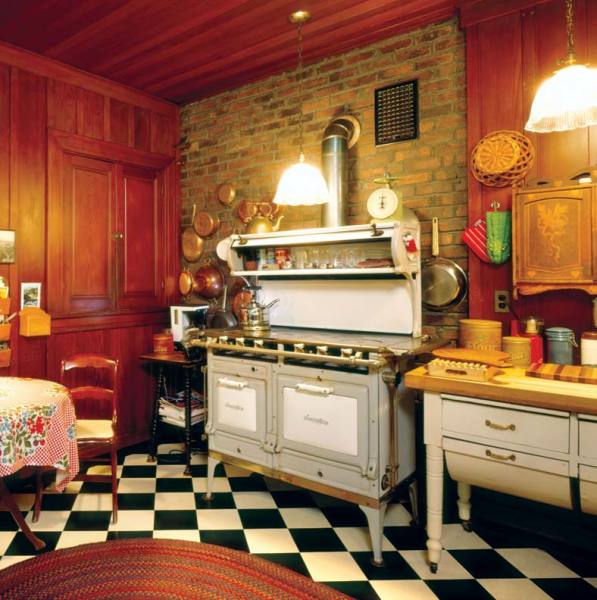
Early Stoves Light Up
From a cooking perspective, the ingredients of the modern kitchen came together only about 200 years ago with the first appearance of a true range—that is, a flat-topped heat source combined with an oven. Credit goes to Benjamin Thompson, better known as Count Rumford, who designed the earliest such cooking devices to scientifically control heat as early as the 1790s. Rumford was an engineering pioneer who made the first scientific studies of heat transfer while perfecting methods for boring cannons. Better known today as the inventor of the Thermos Bottle and the fireplace that bears his name, Rumford’s particular genius in the kitchen was to take the cooking fire out of the open hearth and put it in a box.
Stunningly advanced for 1807, the centerpiece of the Rundlet-May House kitchen in Portsmouth, New Hampshire, is a Rumford range—a brick firebox with iron top (now gone) and registers to control heat. Note the eponymous Rumford Roaster beside the hearth. Courtesy of Historic New England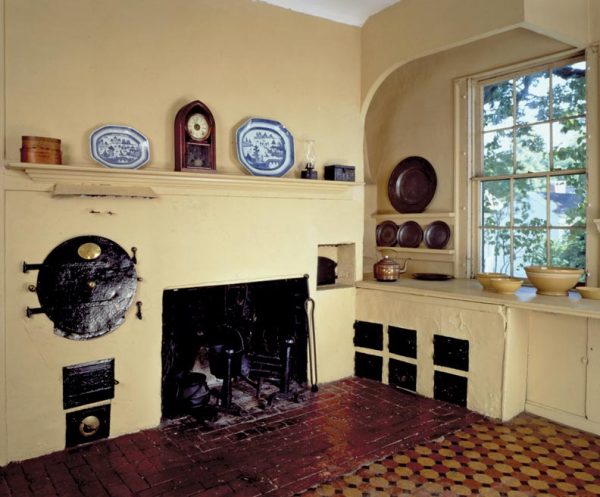
A kitchen equipped according to Rumford’s ideas was dominated by a large range built of brick masonry. Though sometimes connected to the chimney mass, such ranges might also be given their own space. The breakthrough idea was a flat top perforated by round ports of different sizes that opened to the fire below, into which the cook would lower Rumford-designed pots and pans, similar to the operation of some institutional ranges of today. Cast iron seems to have appeared in later versions for tops and firebox doors, and the same kitchen might also include another Rumford innovation: an iron drum with a door that was built into the hearth masonry and called the Rumford Roaster.
The growth of American coal and iron mining in the 1820s made cast iron the wonder material of the 19th century and led to a prolific industry in making stoves for cooking as well as heating. Cast iron could take the repeated temperature swings of hot and cold, and it was an ideal medium for casting into complex, prefabricated parts, as well as for decorative surface ornament. Early metal stoves imported in large numbers from Holland and England came in a variety of boxy designs, but by the 1840s a number of basic stove types—used for laundry, heating, and cooking—had been worked out and were being manufactured widely in America.
Castle Tucker in Wicasset, Maine, is an 1807 museum house preserved to show its appearance in the late 19th century, when even an upscale kitchen was little more than a wood-burning cookstove garnished by a few sticks of functional furniture. Courtesy of Historic New England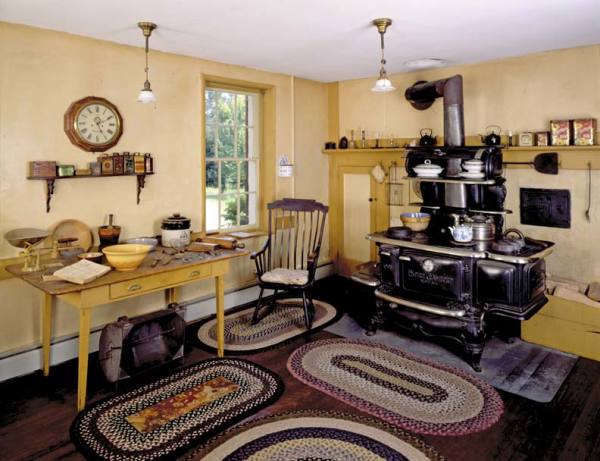
Whatever their use, old stoves were designed to burn wood, but after the Civil War, coal-burning designs came on the scene. While stoves made for cooking as well as heating might be retrofitted to exhaust out an existing hearth and flue, in the best situations they were connected by an umbilical metal stove pipe to a new kind of chimney that was smaller in flue diameter to enhance the draw for the stove. In pre-1830s houses, where there might be only a large central chimney and open cooking hearth, whole new kitchen ells were often built just to accommodate the radically different range.
The Promise of New Fuels
As the Age of Invention waxed in the 1880s and ’90s, stove manufacturers began a search for heat sources beyond wood and coal, and an unlikely combination of forces led them to gas. Always pioneers in the use of gas, English inventors had been experimenting with cooking by gas as early as the 1830s, but it took the maturing of the gas lighting industry to extend the notion to cooking in America. In the 19th century, gas was made from bituminous coal and was primarily an illuminant used to power street and indoor lights. Though gas cooking had found a place in England by the 1860s, and range manufacturers were beginning to ship their product overseas, in America gas was considered too expensive a fuel to be burned for cooking (not to mention the source of an after-taste in some minds).
Two ranges are the main course of the 1910-1925 kitchen at Maymont in Richmond, Virginia. The hood over the coal-burner is evidence of how much heat these units produce.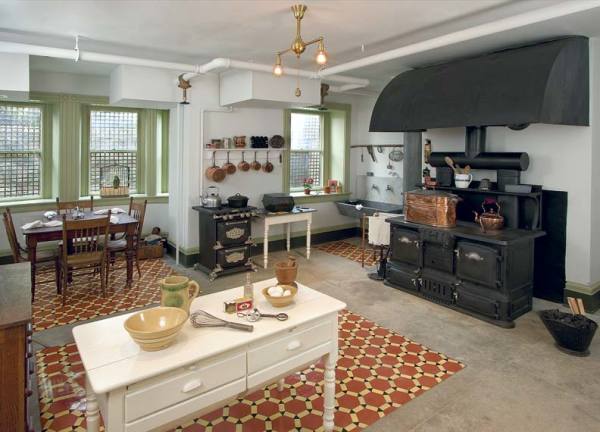
After 1900, though, gas companies were seeing electric power companies nibble away at their bread-and-butter business —lighting—so they turned to the kitchen as the source of a new market. Since gas ranges had no need for the heavy, cast iron box of a wood- or coal-burning range, they could be built in much lighter and more compact forms. Plus gas ranges gave off much less excess heat and had no need for a chimney, making them ideal for the new, smaller kitchens of houses like bungalows. What’s more, they were light enough to stand on tall, slender legs to become, along with sinks, one of several pieces of freestanding furniture in the early modern kitchen.
One of the iconic images of the 1920s kitchen is the special gas cabinet range, with its distinctive barrel-door warming oven on top. Designed for constant use by large families or boarding houses, these ranges combined three or more broiling and baking ovens with multiple burners. Douglas Kiester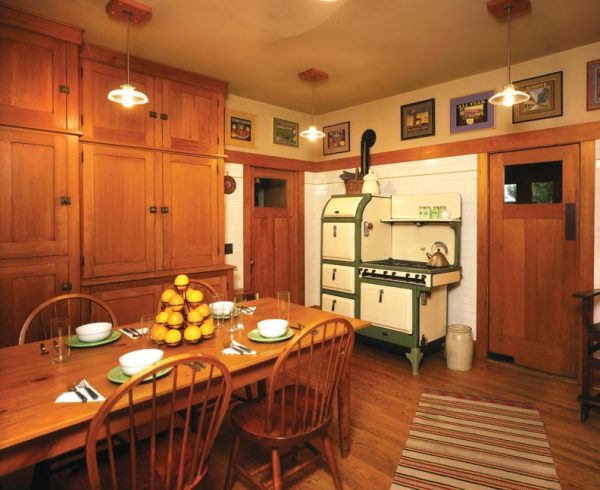
By the 1910s the design of a gas cookstove had arrived at the iconic look of the cabinet range—a burner top at left or right of a baking oven with a broiler below. Ranges were usually constructed of sheet metal and cast iron with a baked enamel finish. Gas fed the burners through an exposed manifold running across the front that was controlled by wheel handle valves or utilitarian cocks. By the Roaring Twenties, the cabinet range hit its stride as a five-burner, two-oven appliance. A popular sales hook was porcelain enameling of all surfaces in black, white, or grey, but the big breakthrough was the invention of reliable heat regulators for controlled oven temperatures.
Gas was not the only fuel innovation, however. The vapor stove, common by the 1890s, capitalized on the new availability of petroleum products in areas where piped-in gas was not available. Also made of iron and sheet steel, these old stoves were light and portable with a styling not unlike the treadle sewing machines of the day. In the 1910s and ’20s, the combination range became quite the rage. These cookers were fired by gas as well as wood or coal, and offered seasonal versatility: coal or wood for added winter warmth, or just gas for cooking in summer heat. In another tug of war, electric appliance manufacturers made their own leap into the cooker market with electric ranges. What started as a glorified electric hot plate around 1917 had gained new ground by 1930 as the electric ranges, looking much like the products of their gas competitors, fed the appetite of a nation pushing to wire for power.
Old Stoves Sizzling in Many Styles
The peak of kitchen taste in the 1930s was a range that looked like a sideboard, dresser, or cabinet—anything but an appliance. Short legs and burner covers helped complete the conceit. National Archives Associates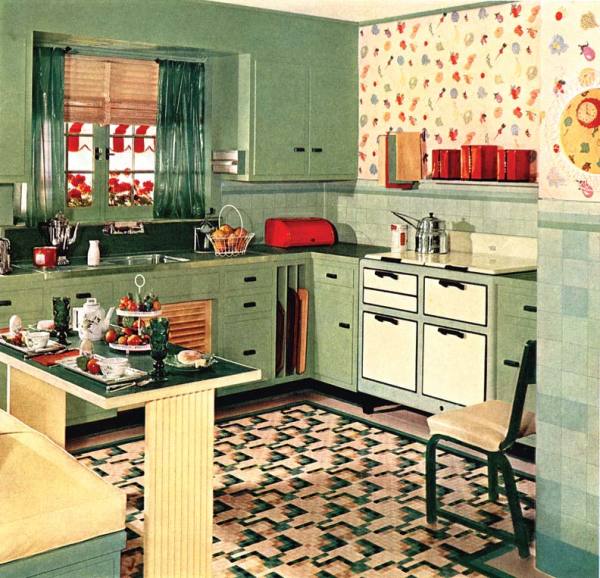
In the early 1930s, gas range manufacturers found a way to hide the gas manifold behind the sheet metal body, and cookers on spindly cabriole legs quickly assumed a new marketing persona as the chest of drawers range. Covers that pulled down over the burner left the appliance hardly recognizable as a stove, according to ads. In the tight times of the Depression, some manufacturers suggested their ranges might even double as tables. Drawer-type handles and decorative legs continued the notion that ranges were furniture—even down to paint finishes that aped materials like marble or wood.
Elmira Stove Works Cayenne Red range. Courtesy Elmira Stove Works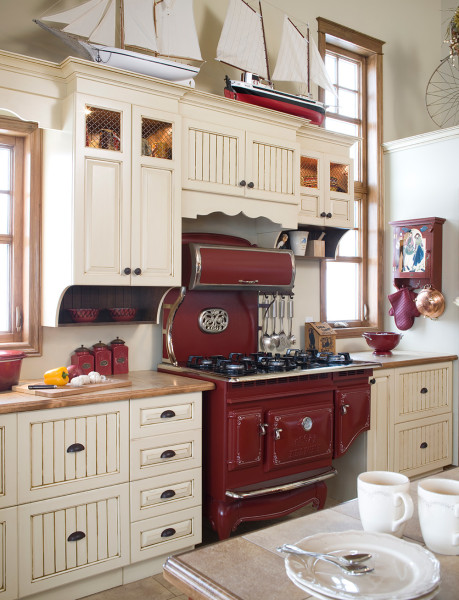
By the end of the decade, the built-in look had arrived, and gas and electric ranges alike suddenly stopped trying to masquerade as freestanding cabinets. The winds of streamline design were blowing through the kitchen, so ranges grew dashboard-like backs that hugged the wall and square-cut corners that fit flush with countertops at either side. Legs became greatly reduced or disappeared altogether. Inspired by the new aerodynamic contours of planes, cars, and trains, designers were adding airfoil curves and chrome speed lines to the most stationary of kitchen appliances. The trend continued through the 1940s and into the post-war years, when ranges became blessed with as many timers, automatic controls, and gadgets as the new automobile-driven economy could connive—a fitting domestic food preparation station for the atomic-era lifestyle to come.







